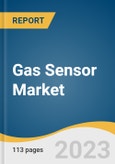The global gas sensor market size is expected to reach USD 5.49 billion by 2030, registering a CAGR of 9.5% from 2023 to 2030. The market growth can be attributed to the increasing number of health and safety regulations by the governments of different countries. Furthermore, the need to constantly control and monitor gas emissions by various industrial processes creates more demand for gas sensors globally.
According to the researchers at Northeastern and Penn State University, wearable gas sensors for human health and environmental monitoring are expected to be commercially available in the coming years. These sensors use a self-heating mechanism that enhances sensitivity and allows for the quick reuse and recovery of the platform.
Miniaturization, smart sensors, multi-gas sensing, IoT integration, and the development of new sensing technologies are key trends shaping the growth and development of the gas sensor industry. IoT-based wireless gas sensors are used in smart cities to predict fire conditions, detect air pollution levels, and track gas combustion. Through IoT gas sensors, air quality data can be collected, processed, analyzed, and exchanged in real-time potentially leading to heathier smart cities. Moreover, gas sensors can potentially help in assessing the levels of various gases such as carbon dioxide, carbon monoxide, and other gases in the air and contribute favorably to curbing air pollution.
The outbreak of the COVID-19 pandemic is anticipated to create new opportunities for the market players. The demand for carbon dioxide gas sensors is expected to increase significantly in particular. Carbon dioxide gas sensors are being used widely in European countries for monitoring the indoor environment in schools to control the spread of coronavirus. Guidelines published by the Federation of European Heating, Ventilation, and Air Conditioning Associations also recommend installing carbon dioxide monitoring systems in schools.
According to the researchers at Northeastern and Penn State University, wearable gas sensors for human health and environmental monitoring are expected to be commercially available in the coming years. These sensors use a self-heating mechanism that enhances sensitivity and allows for the quick reuse and recovery of the platform.
Miniaturization, smart sensors, multi-gas sensing, IoT integration, and the development of new sensing technologies are key trends shaping the growth and development of the gas sensor industry. IoT-based wireless gas sensors are used in smart cities to predict fire conditions, detect air pollution levels, and track gas combustion. Through IoT gas sensors, air quality data can be collected, processed, analyzed, and exchanged in real-time potentially leading to heathier smart cities. Moreover, gas sensors can potentially help in assessing the levels of various gases such as carbon dioxide, carbon monoxide, and other gases in the air and contribute favorably to curbing air pollution.
The outbreak of the COVID-19 pandemic is anticipated to create new opportunities for the market players. The demand for carbon dioxide gas sensors is expected to increase significantly in particular. Carbon dioxide gas sensors are being used widely in European countries for monitoring the indoor environment in schools to control the spread of coronavirus. Guidelines published by the Federation of European Heating, Ventilation, and Air Conditioning Associations also recommend installing carbon dioxide monitoring systems in schools.
Gas Sensor Market Report Highlights
- The oxygen/lambda sensor segment is expected to witness significant growth over the forecast period. The increasing adoption of oxygen gas sensors in applications such as medical equipment, wearable devices, food and beverage production, and environmental monitoring, among others is expected to drive the growth of the segment
- The wireless segment is anticipated to emerge as the fastest-growing segment over the forecast period. The demand for wireless gas sensors is rising owing to the benefits, such as ease of installation and flexibility, real-time monitoring, improved safety, and reduced installation cost as wireless gas sensors require minimal wiring, which saves time and money. In addition, these sensors provide continuous gas monitoring, allowing for prompt identification and response to hazardous situations
- The electrochemical technology segment accounted for the largest market share in 2022. The demand for electrochemical gas sensors is rising owing to the ability of these sensors to detect harmful gas emissions and help in improving air quality. These sensors are widely used in industries such as oil and gas, petrochemicals, and manufacturing to detect toxic and flammable gases
- The environmental end-use segment is anticipated to emerge as the fastest-growing segment over the forecast period. The increasing number of smart city projects being rolled out worldwide is driving the demand for IoT-enabled gas sensors for monitoring environmental gas
- The Asia Pacific region accounted for the largest market share in 2022. Rapid urbanization in emerging economies, such as China and India, is expected to create growth opportunities for the Asia Pacific regional market
Table of Contents
Chapter 1. Methodology and Scope
Chapter 2. Executive Summary
Chapter 3. Market Variables, Trends, and Scope
Chapter 4. Gas Sensor Market: Product Estimates & Trend Analysis
Chapter 5. Gas Sensor Market: Type Estimates & Trend Analysis
Chapter 6. Gas Sensor Market: Technology Estimates & Trend Analysis
Chapter 7. Gas Sensor Market: End-use Estimates & Trend Analysis
Chapter 8. Gas Sensor Market: Regional Estimates & Trend Analysis
Chapter 9. Competitive Landscape
List of Tables
List of Figures
Companies Mentioned
- ABB. Ltd.
- AlphaSense Inc.
- City Technology Ltd.
- Dynament
- Figaro Engineering Inc.
- Membrapor
- Nemoto & Co. Ltd.
- Robert Bosch LLC
- Siemens
- GfG Gas Detection UK Ltd.
- FLIR Systems, Inc.
Methodology

LOADING...
Table Information
| Report Attribute | Details |
|---|---|
| No. of Pages | 113 |
| Published | May 2023 |
| Forecast Period | 2022 - 2030 |
| Estimated Market Value ( USD | $ 2.69 Billion |
| Forecasted Market Value ( USD | $ 5.49 Billion |
| Compound Annual Growth Rate | 9.5% |
| Regions Covered | Global |
| No. of Companies Mentioned | 11 |









